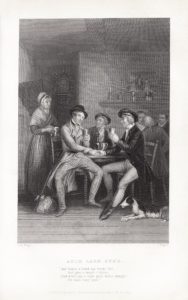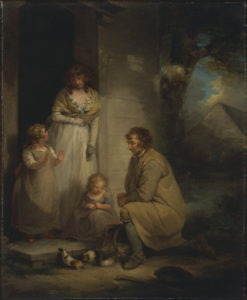I haven’t begun a book with a good shipwreck since my 2008 Harlequin Historical, The Vanishing Viscountess, but, here, ten years later, my next two books begin that very way. They even begin with a shipwreck in about the same place, off the west coast of England.

Here’s the backcover blurb for A Lady Becomes a Governess, coming in June, 2018.
A most unlikely governess…
…with a shocking secretPart of The Governess Swap: Lady Rebecca Pierce escapes her forced betrothal when the ship she’s on wrecks. Assuming the identity of a governess she believes has drowned, she enters the employ of brooding Lord Brookmore, who’s selflessly caring for his orphaned nieces. Inconveniently, she’s extremely attracted to the viscount, with her only chance of happiness tied to the biggest risk: revealing the truth about who she really is…
Shipwrecks were not uncommon occurrences in the 1800s. Wikipedia provides an extensive list for the year 1800, which can give you an idea of how often wrecks can occur.
I’ve read several accounts of shipwrecks in my set of Annual Registers for the years 1810 to 1820. Notably, they almost always stated that all the women and children on board perished.
Here’s an account I found from The New Annual Register or General Repository of History, Politics, Arts, Sciences, and Literature for the Year 1822.
The brig George Captain John M Alpin sailed from Quebec with a cargo of timber for Greenock on the 12th of September last with a crew consisting of nine persons besides three passengers. Early in the morning of the 6th of October she was overtaken by a violent storm which continued without intermission during the day towards sunset the gale increased and the vessel became quite unmanageable. At two o clock the following morning a tremendous sea broke over her and swept away three of her best hands with the companion binnacle, a cable, and boom, and greatly damaged the hull. All hands were then called to the pump, but only three were able to render any assistance. At six o clock they found the vessel to be water logged nothing then remained but to endeavour to gain the main top which with immense difficulty they accomplished, carrying with them one bag of bread about eight pounds of cheese two dozen of wine with a small quantity of brandy and rum. Before they had time to secure themselves in their perilous situation the vessel fell on her beam ends, but within half an hour the hatches blew up and she again righted. Their scanty stores were now examined when to their utter dismay all had been washed except the bag of bread. At this period a distressing scene occurred in the midst of their afflictions. One of the passengers had his wife on board and a child 15 months old, which he carried in his arms. The infant, however, he was compelled to abandon to the merciless waves in the view of its distracted mother. The mainsail was now let down to screen them from the severity of the weather which continued tempestuous until Friday the 11th when they were able once more to go upon the deck. Their thirst had now become excessive and nothing but salt water to be procured. Having found the carpenter’s axe they cut a hole in the deck near to where a water cask had been stowed but alas the cask had been stove and nothing was to be found either for support or convenience but an empty pump can which they carried with them to the main top. That night the female passenger became insensible and next day Saturday 12th she died….
The account continues, describing the extreme measures those remaining took to survive, but after 38 days, only the Captain and one seaman remained to finally be rescued, only to endure another shipwreck before reaching a port. This time, though, all hands survived.
My shipwreck described in my next two books is not quite as perilous, but, as too often happened, most on board perish.
Jane Austen’s World of August 22, 2009, quotes a poem by Wordsworth about the loss at sea of his brother, John, and describes two other shipwrecks of the era. In one, over a hundred people died.
Shannon Selin’s Imagine the Bounds of History blog, tells about the 1822 wreck of the Albion, a packet ship, like in my books. Only nine of the fifty-four on board survived.
As lovely as our beloved Regency period is, it was a time when life was much more precarious than ours today. I don’t often think about that aspect of the Regency. Do you?


 Lately, I’ve been busy reworking some furniture to suit the new life I’m creating for myself. Although I’m more sure about my taste than I used to be, I’m still drawn to design that evokes something of a Regency or neoclassical feel.
Lately, I’ve been busy reworking some furniture to suit the new life I’m creating for myself. Although I’m more sure about my taste than I used to be, I’m still drawn to design that evokes something of a Regency or neoclassical feel.







 Here’s the English translation of
Here’s the English translation of 
